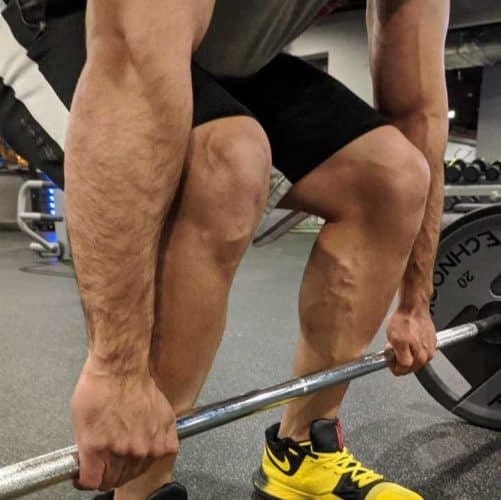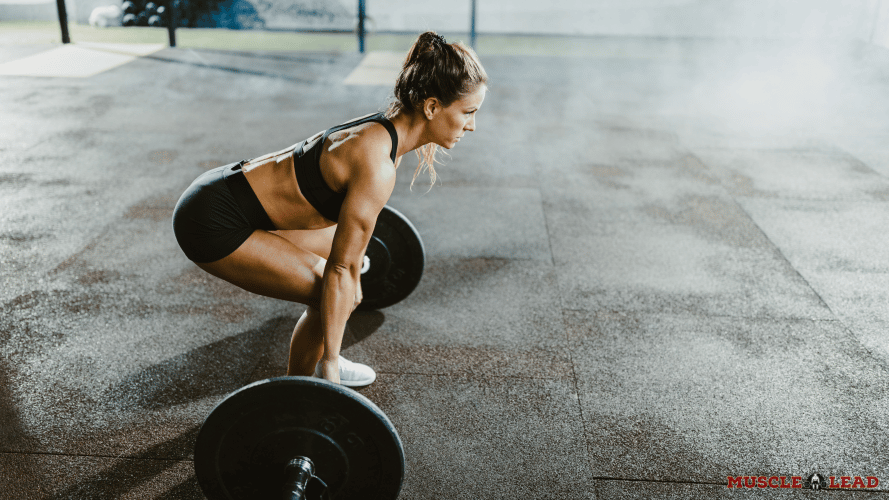The majority of the time, there is nothing complex about why your deadlift is weak off the floor. But so many lifters including myself ask ourselves, why is my deadlift so weak off the floor?
There are three main reasons why you are weak off the floor in the deadlift: (1) Either you have poor lifting technique or (2) weak muscles that start the first half of the lift, or (3) the weight is just too darn heavy. Include various deadlift variations in your workout to improve strength in the various sticking points.
This article is dedicated to bettering the bottom portion of the deadlift, i.e. we will teach you how to get better at the deadlift from the floor.
Movement Actions to Pull the Bar Off the Ground
The deadlift is broken down into 4 movements.
Starting from the ankles, following through to the knees, hips, and upper back. The movements we are looking at when pulling from the floor are the first 2, the ankle and knee.
Plantar-Flexion
When you lift the heel by the ankle this is called plantar-flexion (pushing the ball of the feet against the ground).
This is the very first movement of the deadlift. Think about it, a lifter would press the feet against the ground to chain into other movements.
Knee Extension
Straightening the lower leg from the knee joint is called knee extension. During the deadlift, this movement chains on plantar-flexion of the ankle. (1)
Weak Muscles When Doing Deadlift from the Floor
There are two main muscles, 2 muscle groups that come into action while lifting the bar off the ground.
These muscle groups have a total of 6 muscles that we have highlighted below.
Calf Muscles
The Calf muscles attach around the lower leg. These muscles include the;
- Gastrocnemius (back of lower leg)
- Soleus (outer of lower leg).
The calf muscles start the ankle movement of the deadlift that we discussed before.
Quadriceps
The thigh is actually a group of muscles called the Quadriceps. There are 4 muscles that make up this group, hence the name ‘Quad’. These can be broken down into the;
- Vastus Lateralis (outer thigh)
- Vastus Medialis (inner thigh)
- Vastus inter-medialis (center thigh)
- Rectus femoris (deep center thigh)
Learn more about the 20 Best Exercises for Improving Deadlift Strength
Poor Technique Off the Ground
1. Unsuitable Footwear
Footwear has a huge influence on technique. It can literally make or break lifting the bar off the ground.
You should make sure that the inner sole of your shoe is not spongy. A spongy innersole will absorb the shock of the forces that would normally be started from the feet and ground (2).
So basically footwear like running shoes and crocs are a no-go in my opinion.
2. Too Much Grip Width
Using a grip that is too wide could force the upper body to tilt forward.
In turn, make the lift unnecessarily more difficult, as the load would be placed on the back muscles instead of the legs.
Furthermore, a wider grip may need more range for the bar to complete the lift, making it more difficult to get off the ground.
How to Maximize Your Deadlift Grip
3. Barbell Too Far Away from the Body
Starting with the bar too far away from the shins messes up the deadlift’s center of gravity. Inevitably, this would take you off balance and may load the spine.
Do you know what could happen next? You could either fall over or have a spinal injury.
Another issue is that more range is needed to move the bar off the ground, making the lift harder with more chance of failing. (3)
4. Knees Not Flexed Enough
Some lifters do not really focus much on bending at the knees with the trunk filtered forwards much. This position takes most of the tension off of the quadriceps, similar to a straight leg deadlift.
If a lifter ever converts back to a proper deadlift position, the reality is that the quadriceps may have been neglected with a poor lift off the ground.
Strengthen Muscles Used in Deadlifts
We have included 4 exercise recommendations that could help you bring out the strength in the lower and upper legs.
1. The Front Squat
To Perform the front squat the bar needs to be placed on the front of the shoulder and upper chest.
This shifts the mechanics of the squat. The trunk of the body would become more upright.
From here we would have less hip movement, putting most of the emphasis on the knees movement and hitting the calves and quadriceps.
Over time, this could help build bigger and stronger quadriceps. It only makes sense better the knee movement off the ground during the deadlift.
2. Additional Isolation Exercises
We could try to get some extra stimulus on the Calf and quadricep muscles. To do so, a lifter could slot in some isolation exercises after the deadlift or on a completely separate session.
These exercises could include;
- Knee Extension Machine
- Calf Raise Machine
- Cable Knee Extensions
- Smith Calf Raises
3. Deficit Deadlift
A deficiency deadlift is basically just a deadlift performed with the feet placed on a platform higher than the ground.
This could be done off a step board or a few weight plates to elevate you by 3-5″.
The higher platform forces a lifter to bend the knees and ankles more to grasp the bar. This can tap into more muscle fibers of the calves and quadriceps and strengthen them over time.
4. Pause Deadlift
So in this deadlift variation, you could pause in the position where you are the weakest.
So for those of you who are weak off the floor, pause at the middle of the shin bone for 2-3 seconds.
This would put some additional tension on the calf and quadricep muscles, and strengthen them in the long term.
Learn more about The Isometric Deadlift to Improve Strength
How to Fix Technique Off the Ground
The 4 most important tips for fixing the deadlift from the floor technique have been discussed below.
1. Use Appropriate Footwear
Suggested footwear for the deadlift could be flat shoes or even weightlifting shoes during certain situations
These shoes have a solid inner sole to push the feet against the ground.
Secondly, these shoes have a non-slip outer sole that can help a lifter to keep a stable deadlift foot position.
Should You Deadlift With Lifting Shoes or Barefoot?
2. Shoulder Width Grip
This one is pretty simple. With the feet positioned just outside hip-width apart, the grip should be just outside that. So around shoulder width.
This is a great pointer to avoid gripping the bar too wide, especially if you are relatively new to the deadlift.
3. Pinning The Bar Against The Shin
Pinning the bar against the shins should give a proper center of gravity for balance, and to keep the spine in a safe position (3).

Not to mention, a lifter would not have to extend further to grasp the bar for a more efficient and effective lift.
Fix Deadlift Shin Scrapes and Bruises
4. Optimize Knee Bend
I remember back to my Biomechanics class, we were looking at the knee bend for optimal extension power on the biodex dynamometer.
The strongest position was between 45° and 90°. Anything more or less was not as effective, as the muscle fibers were either not connected enough or overlapping.
For this reason, a lifter could try flexing the knees down to roughly between 45° and 90°. Of course, the sweet spot would vary from person to person.

Remember to back the hips up enough to aid the knee bend.
Final Thoughts
There are two main reasons why lifters might find it difficult to deadlift from the floor.
The first reason is a lack of calf and quadricep muscle strength, as these muscles move the ankle and knee joints.
Second of all, a lifter may have poor technique.
This could include;
- Unsuitable footwear/poor foot pressing forces
- Grip width too wide
- Starting the lift with the bar too far away from the body.
Nevertheless, these issues can be addressed. Some of the recommendations are quick fixes and others take a little longer.
Frequently Asked Questions
I would think about pushing the feet against the ground and straightening the knee while pulling the bar at the same time. If you think about just pulling the bar, you might use too much back.
If you are going really heavy, say the maximum effort, and your grip strength is what’s letting you down, you could use the lifting straps.
A little bit, but the glutes come into action from the hip hinge movement, which is most active ¾ of the way through the lift.
References
- Heelas, T., Theis, N., Hughs, J.D. ‘Muscle Activation Patterns During Variable Resistance Deadlift Training With and Without Elastic Bands’ The Journal Of Strength & Conditioning Research. 2021;35(11): 3006–3011
- Sato, K., Forenbaugh, D., Haydock, D.S., et al. ‘Comparison of back squat kinematics between barefoot and shoe conditions’ International Journal of Sports Science & Coaching. 2013; 8(3): 571–578
- Mysyszek, K.K., Harmon, R.A., Dunick, D.D., et al. ‘Comparison of Olympic and Hexagonal Barbells With Midthigh Pull, Deadlift, and Countermovement Jump’ Journal of Strength and Conditioning Research. 2017; 31(1): 140–145





